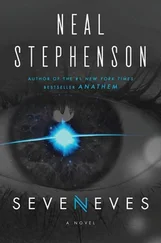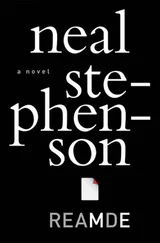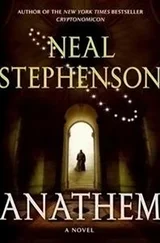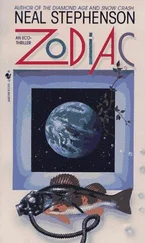After the conversation at Tom Howard's last night, Randy slept in his guest room and then spent most of the day in Kinakuta buying a new laptop, complete with a new hard drive, and transferring all of the data from the drive he salvaged in Los Altos onto the new one, encrypting everything in the process. Considering all of the completely boring and useless corporate documents he has subjected to state-of-the-art encryption, he can't believe he carried the Arethusa stuff around on his hard drive, unencrypted, for several days, and across a couple of national borders. Not to mention the original ETC punch-cards, which now reside in Tom Howard's basement safe. Of course that stuff is encrypted to begin with, but that was done in 1945, and so by modern standards it might as well have been enciphered with a cereal-box decoder ring. Or at least that is what Randy is kind of hoping. Another thing he did this morning was to download the current version of the Cryptonomicon from the ftp server where it lives in San Francisco. Randy's never looked at it in detail, but he has heard it contains samples of code, or at least algorithms, that he could use to attack Arethusa. With luck, the very latest public code-breaking techniques in the Cryptonomicon might match up to the classified technology that Pontifex and his colleagues were employing at the NSA thirty years ago. Those techniques didn't work against the Arethusa messages that they were trying to decrypt, but this was probably only because those messages were random numbers—not the real messages. Now that Randy has what he suspects are the real messages, he may be able to accomplish what Earl Comstock tried and failed to do during the fifties.
They are angling across the terminator—not the robotic assassin of moviedom, but the line between night and day through which our planet incessantly rotates. Looking east, Randy can see over the rim of the world to places where it is dusk, and the clouds catch only the reddest fraction of the sun's light, squatting in darkness but glowing with sullen contained fire like coals in their feathery ruffs of ash. The airplane is still in the daylight, and is assiduously tracked by mysterious bars of rainbow, little spectral doppelgangers—probably some new NSA surveillance technology. Some of the Palawan's rivers run blue and straight into the ocean and some carry enormous plumes of eroded silt that feather out into the ocean and are swept up the shore by currents. In Kinakuta there is less deforestation than there is here, but only because they have oil instead. All of these countries are burning resources at a fantastic rate to get their economies stoked up, gambling that they'll be able to make the jump into hyperspace—some kind of knowledge economy, presumably—before they run out of stuff to sell and turn into Haiti.
Randy is paging his way through the opening sections of the Cryptonomicon, but he can never concentrate when he's on an airplane. The opening sections are stolen pages from World War II-era military manuals. These used to be classified until ten years ago, when one of Cantrell's friends found copies just sitting in a library in Kentucky and drove there with a shitload of dimes and photocopied them. That got public, civilian cryptanalysis up to where the government was in the l940s. The Xeroxes have been scanned and OCRed and converted to the HTML format used for Web pages so that people can put in links and marginal notes and annotations and corrections without messing with the original text, and this they have done enthusiastically, which is all very well but makes it hard to read. The original text is set in a deliberately crabbed, old-fashioned typeface to make it instantly distinguishable from the cyber-era annotations. The introduction to the Cryptonomicon was written, probably before Pearl Harbor, by a guy named William Friedman, and is filled with aphorisms probably intended to keep neophyte code-breakers from slapping grenades to their heads after a long week of wrestling with the latest Nipponese machine ciphers.
The fact that the scientific investigator works 50 percent of his time by nonrational means is, it seems, quite insufficiently recognized.
Intuition, like a flash of lightning, lasts only for a second. It generally comes when one is tormented by a difficult decipherment and when one reviews in his mind the fruitless experiments already tried. Suddenly the light breaks through and one finds after a few minutes what previous days of labor were unable to reveal.
And, Randy's favorite,
As to luck, there is the old miners' proverb: “Gold is where you find it.”
So far so good, but then with a few whacks of the Page Down key Randy's looking at endless staggered grids of random letters (some kind of predigital method for solving ciphers) which the author would not have put into the document if they did not convey some kind of useful lesson to the reader. Randy is miserably aware that until he has learned to read through these grids he will not even be up to the level of competence of a World War II novice cryptanalyst. The sample messages used are like ONE PLANE REPORTED LOST AT SEA and TROOPS HAVING DIFFICULTY MAINTAINING CONNECTION WITH FORTY FIFTH INFANTRY STOP which Randy finds kind of hokey until he remembers that the book was written by people who probably didn't know what “hokey” meant, who lived in some radically different pre-hokiness era where planes really did get lost at sea and the people in those planes never came back to see their families and in which people who even raised the issue of hokeyness in conversation were likely to end up pitied or shunned or maybe even psychoanalyzed.
Randy feels like a little shit when he thinks about this stuff. He wonders about Chester. Is the shattered 747 hanging from Chester's ceiling just a monumental act of bad taste, or is Chester actually making a Statement with that thing? Could it be that nerdy Chester is actually some kind of deep thinker who has transcended the glibness and superficiality of his age? This very subject has been debated by serious people at some length, which is why learned articles about Chester's house keep showing up in unexpected places. Randy wonders if he's ever had a serious experience in his life, an experience that would be worth the time it would take to reduce it to a pithy STOP-punctuated message in capital letters and run it through a cryptosystem.
They must have flown right by the site of the wreck. In a few days Randy will turn right around and come halfway back to Kinakuta to make what meager contribution he can to the job of dragging gold bars out of it. He's only going to Manila to take care of some business there; some kind of urgent meeting demanded by one of Epiphyte's Filipino partners. The stuff that Randy came to Manila to do, a year and a half ago, mostly runs itself now, and when it actually requires his attention he finds it fantastically annoying.
He can see that the modern way of thinking about stuff, as applied to the Cryptonomicon, isn't going to help him very much in his goal of decrypting the Arethusa intercepts. The original writers of the Cryptonomicon actually had to decrypt and read these goddamn messages in order to save the lives of their countrymen. But the modern annotators have no interest in reading other people's mail per se; the only reason they pay attention to this subject at all is that they aspire to make new crypto systems that cannot be broken by the NSA, or now this new IDTRO thing. The Black Chamber. Crypto experts won't trust a cryptosystem until they have attacked it, and they can't attack it until they know the basic cryptanalytical techniques, and hence the demand for a document like this modern, annotated version of the Cryptonomicon. But their attacks generally don't go any further than demonstrating a system's vulnerabilities in the abstract. All they want is to be able to say in theory this system could be attacked in the following way because from a formal number-theory stand point it belongs to such-and-such class of problems, and those problems as a group take about so many processor cycles to attack. And this all fits very well with the modern way of thinking about stuff in which all you need to do, in order to attain a sense of personal accomplishment and earn the accolades of your peers, is to demonstrate an ability to slot new examples of things into the proper intellectual pigeon-holes.
Читать дальше





